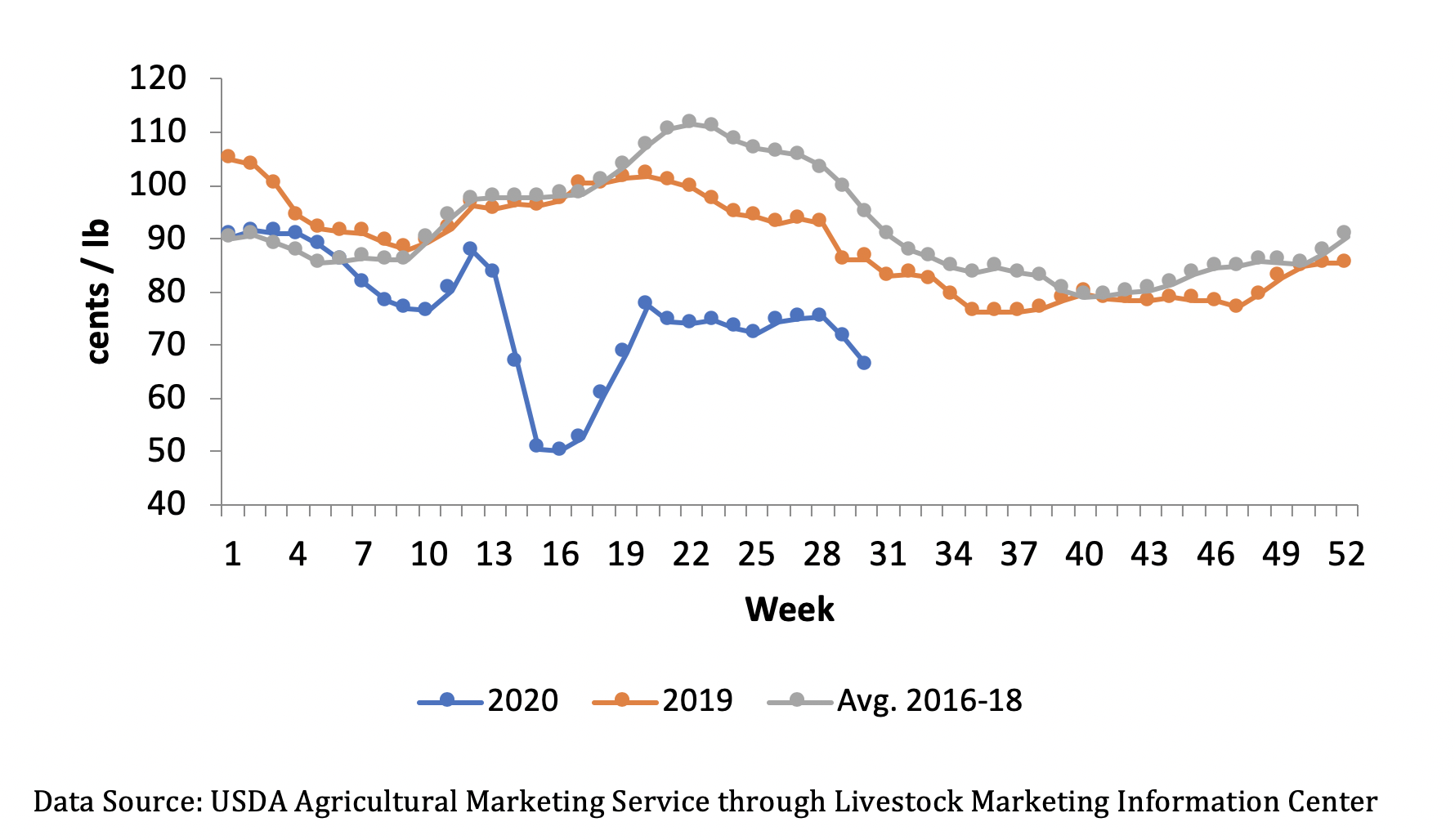July 31, 2020
U.S. chicken production, prices down
By Ryan McGeeney
U of A System Division of Agriculture
Fast Facts:
- 2020 chicken slaughter averaging about 3.5 percent below 2019 numbers
- 2020 market prices have fallen as low as 50 percent of prices seen in 2016-2019
(509 words)
(Download this story in MS Word format here.)
(Newsrooms: With graphics at https://flic.kr/p/2jrCYin and https://flic.kr/p/2jrCYhq)
FAYETTEVILLE, Ark. — Numbers for both the production of chicken and the market price it fetches in the United States have remained low throughout the year, as compared to both 2019 figures and those averaged from 2016-2018, according to a recent economic analysis from the University of Arkansas System Division of Agriculture.
John Anderson, head of the agricultural economics and agribusiness department of the University of Arkansas System Division of Agriculture and the Dale Bumpers College of Agricultural Food and Life Sciences, authored the report. The update is part of an ongoing analysis from the Division of Agriculture, examining the economic impacts of the COVID-19 pandemic on agriculture and other aspects of society in the United States.
“Data on broiler processing volumes suggest that, while the sector has recovered from the worst of the massive shock from COVID-19, the effects of the pandemic are still being felt,” Anderson said.
According to data from the U.S. Department of Agriculture, boiler processing remained above 2019 numbers for about the first three months of 2020, averaging about 170 million head a week, about 10 million more than same-week numbers from the previous year. Since late March, however, 2020 figures have remained at or below those of 2019.
“Processing volumes have bounced back from the sharp declines posted at the end of April,” Anderson said, “but those volumes remain consistently below 2019 levels — despite the fact that the industry was on pace for a substantial year-over-year increase in production at the beginning of 2020. Since the beginning of April, young chicken slaughter has averaged about 3.5 percent below the prior year level.”
Prices dragging
Prices, meanwhile, have suffered more severely in 2020. After a high point of about 91 cents per pound in the early weeks of January, prices fell to varying degree, ultimately bottoming out at about 50 cents per pound in late April into early May. While prices did rebound over the following month to about 77 cents per pound, they have fallen gradually since, arriving at about 66 cents per pound as July draws to a close. During the same seven months in 2019, prices fluctuated between more than $1.04 per pound and 86 cents a pound. Average prices for those months during the 2016-2018 period ranged from about 85 cents per pound to as high as $1.11 per pound.
The “continuing lag in broiler production most likely understates the negative effects of COVID on the industry, capturing primarily the supply-side effects of processing plant disruptions,” Anderson said. “Despite the reduced availability of product, broiler prices are mostly lower than year-ago levels.
“With steady demand, a down shift in supply would result in an increase in prices,” Anderson continued. “The current lower prices accompanying a lower supply suggest a decline in demand — not too surprising given the negative impact of COVID on the general economy and particularly on the food service sector. Lower prices and production ultimately mean lower value in the sector. As noted, this is a relatively dramatic swing for an industry that was anticipating robust growth before the pandemic hit.”
To learn more about extension programs in Arkansas, contact your local Cooperative Extension Service agent or visit www.uaex.uada.edu. Follow us on Twitter at @UAEX_edu.
About the Division of Agriculture
The University of Arkansas System Division of Agriculture’s mission is to strengthen agriculture, communities, and families by connecting trusted research to the adoption of best practices. Through the Agricultural Experiment Station and the Cooperative Extension Service, the Division of Agriculture conducts research and extension work within the nation’s historic land grant education system.
The Division of Agriculture is one of 20 entities within the University of Arkansas System. It has offices in all 75 counties in Arkansas and faculty on five system campuses.
Pursuant to 7 CFR § 15.3, the University of Arkansas System Division of Agriculture offers all its Extension and Research programs and services (including employment) without regard to race, color, sex, national origin, religion, age, disability, marital or veteran status, genetic information, sexual preference, pregnancy or any other legally protected status, and is an equal opportunity institution.
# # #
Media contact:
Ryan McGeeney
Communications Services
University of Arkansas System Division of Agriculture
Cooperative Extension Service
(501) 671-2120
rmcgeeney@uada.edu
